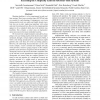Free Online Productivity Tools
i2Speak
i2Symbol
i2OCR
iTex2Img
iWeb2Print
iWeb2Shot
i2Type
iPdf2Split
iPdf2Merge
i2Bopomofo
i2Arabic
i2Style
i2Image
i2PDF
iLatex2Rtf
Sci2ools
ISCA
2003
IEEE
2003
IEEE
Virtual Simple Architecture (VISA): Exceeding the Complexity Limit in Safe Real-Time Systems
Meeting deadlines is a key requirement in safe realtime systems. Worst-case execution times (WCET) of tasks are needed for safe planning. Contemporary worst-case timing analysis tools can safely and tightly bound execution time on in-order single-issue pipelines with caches and static branch prediction. However, this simple pipeline appears to be a complexity limit, due to the need for analyzability. This excludes a whole class of high-performance processors from many embedded systems. We reconcile the complexity/safety trade-off by decoupling worst-case timing analysis from the processor implementation, through a virtual simple architecture (VISA). A VISA is the timing specification of a hypothetical simple pipeline and is the basis for worst-case timing analysis. However, the underlying microarchitecture can be arbitrarily complex. A task is divided into multiple sub-tasks which provide a means to gauge progress on the complex pipeline. Each sub-task is assigned an interim deadline...
Hardware | Hypothetical Simple Pipeline | ISCA 2003 | Simple Pipeline | Worst-case Timing Analysis |
| Added | 04 Jul 2010 |
| Updated | 04 Jul 2010 |
| Type | Conference |
| Year | 2003 |
| Where | ISCA |
| Authors | Aravindh Anantaraman, Kiran Seth, Kaustubh Patil, Eric Rotenberg, Frank Mueller |
Comments (0)

